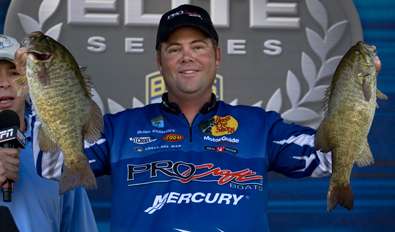
In this second installment of small water angling, we look at streams. Streams are more common than any other type of water throughout the U.S., as even the smallest trickles can offer easy, cheap bassin'.
Elite Series pro Brian Snowden grew up fishing small waters and continues to wade and float small streams near his Reeds Spring, Mo., home. Through similar in makeup, Snowden says streams and rivers are different animals and call for different approaches.
Before you head out for a day's wading or floating, take a quick look around the banks to see if bass are around.
"You can tell pretty quickly if there are bass in the area you are going to be fishing. Take a look at the edge of the shallows. If there aren't any crawfish, minnows or shad, it's going to be tough," he said. "However, if there's flowing water, there is usually bait, and if there's bait, the sportfish aren't far behind."
Take it easy
Every aspect of stream fishing is simple. While it can become overcomplicated with rods, reels, baits and other things, Snowden catches oodles of bass with just one rod, a Plano box or two and some worms. No need to unload piles of baits from a bass boat, just swap boxes to season-appropriate baits. To differentiate, Snowden uses this rule of thumb.
"Streams are typically not as wide, have swifter current and are clearer, so more natural colored baits work best," he said. "Rivers are usually deeper, wider and have more color, meaning brighter baits work best, but this isn't always true."
He goes on to say since most streams are similar, you can get away with one rod and reel year-round. His favorite is a 6-foot — or 6-foot, 6-inch — medium action spinning reel with 8-pound monofilament. He favors mono for its versatility.
"If you try to use fluorocarbon with a topwater, it will kill the action of the bait as it sinks, that's why I stick with monofilament," he said. "Monofilament works just fine for everythingSnowden has found the best stream fishing is in the summer. The bass are more concentrated and will hit a wider variety of baits. In his summertime tacklebox are some green pumpkin Zoom Finesse worms he fishes on a 1/8- or 1/16-ounce Slider Head.
"The bass are easier to locate in the summer. They relate more to current as the water warms," he said. "Water on the outside of the channel swing is deeper and calmer. This is where you want to work."
Snowden says an important part of working this slack water is allowing your bait to move naturally downstream. Casting his worm to the bank above the swing, Snowden will let it bump and move naturally along the bottom if there is some current, and if not, he will hop it and pull it along.
If there are laydowns or matted vegetation, Snowden goes to a small (1/8-ounce) white buzzbait and works it along this cover. He'll also throw small Rapalas to the downside of current to ripples below a pool. He will stick to this pattern through early fall.
In fall, Snowden will begin to phase out the buzzbait as the water cools and replace it with small crawfish imitators.
"In the fall, fish are feeding on craws more, so I like to throw Zoom Critter Craws," he said. "However, I'll throw the Slider Head year-round. You just get a lot of bites on it. They may not be big bites in streams, but the light tackle makes it a lot of fun if you do happen to hook a 2-pounder."
As the water cools even more, Snowden says the bass seek out rocky banks and bluffs, where the water stays warmer and warms faster each morning. Around these rocky areas he throws the small buzzbait, or a small craw-patterned crankbait or a jerkbait. The one constant is the Slider Head.
"The fish will seek out slacker water in the colder months. It's usually deeper and is less likely to freeze if it gets that cold," he said. "It's also where the crawfish congregate for the same reasons."
As spring rolls around and the water warms (or thaws), the bass return to slack water for the spawn.
"The fish will head to calm water around gravel or rocky bottoms, or flat banks to lay eggs," he said. "The Slider Head really shines in these areas; you almost can't go wrong with it."
You'd be hard-pressed to find fishing as easy and enjoyable as fishing on a picturesque stream. Take a look at Google Earth to find tributaries that feed nearby rivers or small, overlooked runoffs. Odds are you'll be extremely pleased with what you find.
"Streams offer relaxation and a cheap way to fish. They're really simple and accessible, and you can catch a bunch of fish in one trip." Snowden said.




